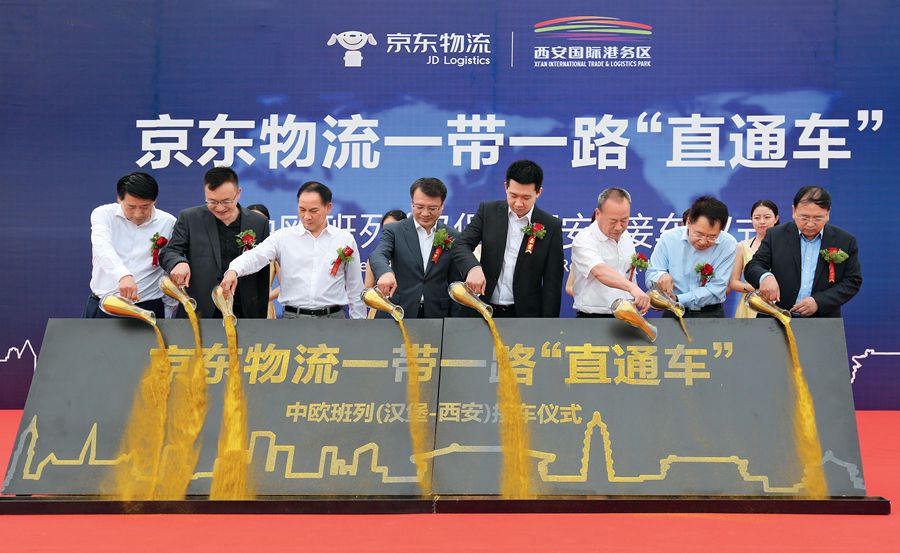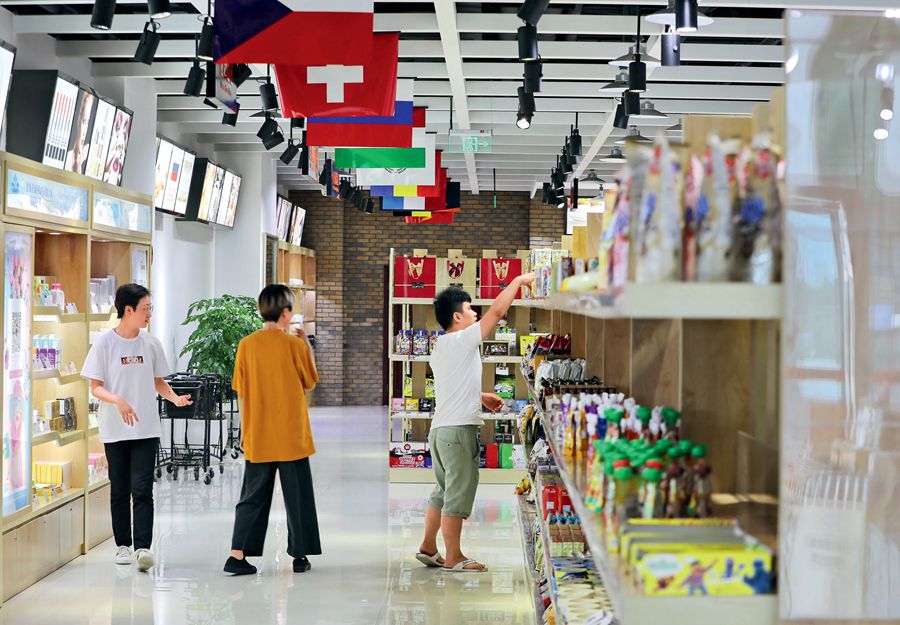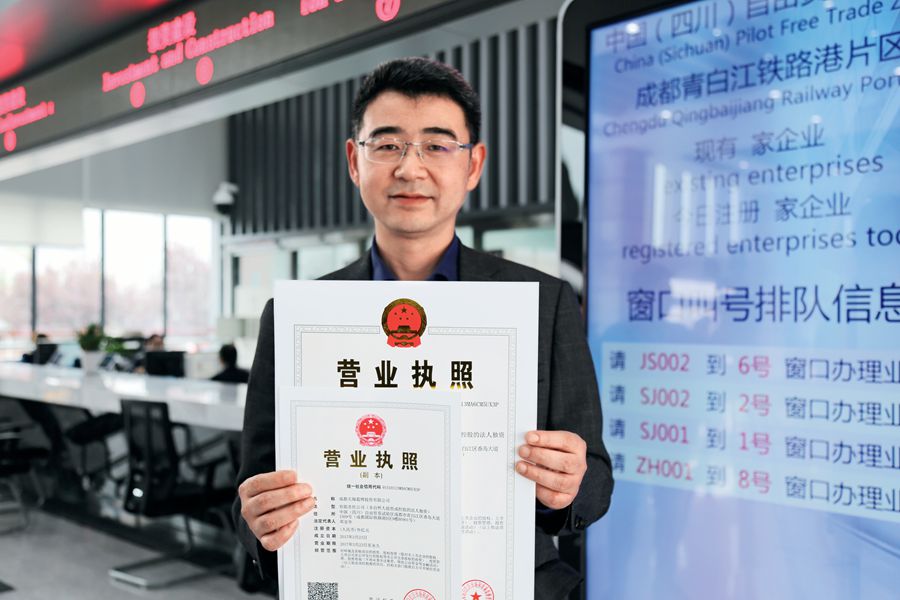ON April 26, 2013 the first China Railway Express (CRE) train left Qingbaijing in China’s Chengdu City for Lodz in Poland. Wang Hongfu, employed at Chengdu International Railway Service Co., Ltd. (CDIRS), was a witness to that historical moment.
“I was one of the only two employees for on-site allocation of container goods in my company, now the team has grown to more than 20 people,” Wang said. The development of his department is an indicator of the growth in the volume of goods transported by CRE. Five years ago one train commuted between Chengdu and Europe each week – today the number is three daily.

On May 21, 2018 China’s online retail giant jd.com launches a freight train service between Hamburg and Xi’an.
CRE operates freight transportation services between China and Europe, and countries along the Belt and Road route. It completed over 9,000 trips between March 2011 and June 2018, delivering nearly 800,000 standard containers of goods between 48 Chinese cities and 42 cities in 14 European countries. Reaching major cities in Asia and Europe, the CRE rail is a key logistic route for countries along the Belt and Road.
International Appeal
Kasper Kristensen hails from Denmark and fell in love with China on his first visit 20 years ago. Since then he has spent vacations in the country every year. Last September he came to Chengdu to promote his milk formula brand Royal Farm, hoping the CRE would offer new business opportunities.
“In the past, many established Danish brands had little knowledge of the Chinese market. They now have noticed the big demand in China, but have no idea of how to exploit it,” Kristensen said. He and his Chinese business partner Fu Tian decided to capitalize on this gap by selling Nordic products to China. The CRE is a great help for the realization of their ambition.
“So far, nearly 50 popular brands from northern Europe have decided to cooperate with us. Their products will reach China on CRE trains, which are fast and economical. Our cooperation will be a win-win one,” said Fu Tian, upbeat about the business prospects.
“I hope to bring the best products of northern Europe to Chengdu and China at large, so people here will love our products, and enjoy a better quality of life,” Kristensen added.
Andrew Ye, a Chinese American, and Guillaume Chamant of France, both work for Sichuan Rongouzhilian Technology Co., Ltd., which imports wine from Europe to China through online cross-border business platform Haioo. Its business also relies on CRE services. “I left my job in the U.S. to work in Chengdu, because of the promising future brought about by the CRE. I hope my company will grow in tandem with the train service,” Ye said. “I love China and Chinese culture. I hope to learn more of the Chinese language and grow together with my company,” said Guillaume Chamant. He became fascinated with Chengdu during two-year study at the International Trade Department of Sichuan Agricultural University. Like Kasper Kristensen, Fu Tian, Andrew Ye, and Guillaume Chamant, people from all over the world are working on their respective dreams that have been made possible by the CRE. With the increasing number of trains operated between China and Europe in the past two years, more quality European products have entered Chengdu and beyond to other parts of China. CRE is an increasingly important bridge between the European market and Chinese consumers.
Facilitating Cross-Border Trade
The opening of CRE has made the parallel import of cars (legal in China) a soaring business. To date 40-plus trade companies have set up operations at the Chengdu International Railway Port. “The brands imported include Bentley, Maserati, Mercedes-Benz, BMW, Land Rover, and Dodge. It only takes 10-odd days to bring European cars to Chengdu via CRE,” said Zeng Yi, an official with the Management Committee of Chengdu International Railway Port.

A store at the Chengdu International Railway Port sells a good variety of imported goods.
Besides Europe, North America and the Middle East are the two other sources of parallel import of cars to China. For imports from these two regions, intermodal freight is used, which allows freight to ship by rail and results in economic benefits. “Chengdu is the first inland city in China that parallel imports cars from the U.S. by ocean-rail services. With the import route between Chengdu and Qingzhou of Shandong Province in the works, we will expand whole-car import business to Central Asia,” said Zeng.
Central Asia is the world’s largest source market of automobiles at the lowest prices, Zeng added. The port is working to bring parallel import cars at the lowest price possible to consumers in Chengdu and southwestern China, so average citizens can benefit from international rail services, including those provided by CRE. “Without the surcharge by middlemen, we will make imported cars affordable to average consumers.” This is the goal of the Chengdu port, according to Zeng.
Zhou Yong runs a trading company in Chengdu, called Taste of Germany. He worked as a steward on a Dutch airliner when the news came that the CRE (Chengdu) launched container services for cross-border e-business. Anticipating a business bonanza in the area, he resigned from his well-paid job, and founded a company in April 2017. He is now the general agent of German wine maker Heuchelberg Weingärtner in China. “The winery was pondering on entering the Chinese market, which was made easy by the CRC (Chengdu). After a meeting with its boss, we started cooperation,” recalled Zhou.
From July 2017 to January 2018 Zhou imported 14,000 bottles of wine in two groups from Germany, which were shipped to tax-free warehouses in Chengdu before being delivered to buyers. At the time of writing the third batch was on its way to China on a CRE train.
Zhou opted for cross-border e-business because the CRE (Chengdu) service shortens the transport time, and the tax on such imports is low. “Generally the commodity tax for international trade is 48.2 percent, while that for cross-border e-business is only 21 percent,” he explained.
“We launched a special container service for cross-border e-business last year. Since then, the smooth operation of CRE has guaranteed the development of cross-border e-business. This year we will open up more channels for its business, and hence boost the confluence of cross-border e-business companies in the region,” said Qiao Peishu, vice director of the Bureau of Commerce of Qingbaijiang District, Chengdu.
The district is now home to 36 companies engaging in cross-border e-business. They deal mostly in fast moving consumer goods, such as wine and maternal and child supplies, and reported remarkable growth in business last year.

First business license issued in the Qingbaijiang Railway Port in the Chengdu Free Trade Zone.
“Riding the wave of investment flowing into the Chengdu Free Trade Zone, we set up an industrial park for cross-border e-business companies,” said Qiao. “We also provide customs clearance services that can be booked around the clock. We have carried out promotion events to attract e-business companies, and stepped up cooperation and exchanges with countries along the Belt and Road with the aim of increasing the quality and variety of our e-business products.”
Earlier this year, CRE initiated a freight-trade integration service for logs from Siberia to Chengdu, a hub of wood trade in southwestern China. From there containers carrying Russian logs can reach the entire market of southwestern China. Between March and June of this year the special train service for Russian logs made 55 trips to China.
An Extending Rail Network
Last year Li Chengyuan, an employee of Chengdu International Railway Services Co. Ltd. (CDIRS), was transferred to a railway station and yard of the company in Malaszweicze, a town in Poland. “The town covers a large territory with a small population. There are few jobs for young people, so most of them move to big cities like Warsaw and Kraków, and the remaining work in our logistics business,” he said. The Belt and Road Initiative and the opening of the CRE line have created jobs for local residents.
“When I first walked out of the Warsaw Chopin Airport, I saw many Chinese elements on the street, like a billboard of Huawei mobile phones, a video about giant panda on a big TCL screen, and Chinese restaurants,” Li recalled. As he spent more time in the country, he was more impressed with how the CRE service and the operation of other Chinese companies have boosted local economy. “One day I was invited to a TCL factory in Zyrardów City. When I was told by its logistics manager that only three Chinese worked there and the other 300 employees were all hired locally, I understood that this renowned Chinese company was taking its social responsibilities seriously.” Before the CRE line was extended to the region, the TCL factory in Zyrardów imported parts for the electronic appliances it produces by sea, which took 33 days from Shenzhen or Shanghai to Gdansk in Poland. They would then be transported to the factory by road over five days. After the CRE opened the Chengdu-Europe line, the parts can be directly loaded on trains at Huizhou, a Chinese city, where the items are manufactured, and travel overland to the TCL factory in 21 days. The efficiency has been significantly improved.
According to Li, during the World Cup 2018, TV sales soared in Europe, and as a result TCL increased its parts imports exponentially, which led to a rise in local workers’ income. “Following the opening of the CRE line, a number of cargo yards have been established in Lodz. They contribute to the city’s economic growth and increase local employment rate, bringing greater happiness to local residents,” Li said. The CRE train brings tangible benefits to people living along its route, connecting China with Europe and the rest of the world and forging friendship globally.
“In the first seven months of this year the CRE (Chengdu) has run 600 international trains, among which nearly 500 go to Europe and the rest to Central Asia and ASEAN,” said Zeng Yi. International rail lines including CRE are extending from Chengdu to all directions, building a new Eurasian Land Bridge. So far CRE services have reached Lodz and Malaszewicze in Poland, Nürnberg in Germany, Moscow and Tomsk in Russia, Istanbul in Turkey, Minsk in Belarus, Smögen in Switzerland, Almaty in Kazakhstan, Prague in Czech Republic, Tashkent in Uzbekistan, Gent in Belgium, Milan in Italy, and ASEAN. It has 16 international rail lines that connect Chengdu with Europe in the west, with Russia in the north and with ASEAN in the south. Also reaching 14 coastal or border cities across China, CRE (Chengdu) is a linchpin in both domestic and international rail transport networks.
“Look at the red lines on the map,” said Zeng Yi. “International rail lines including the CRE are like red ribbons that string countries and cities together along the Belt and Road, making their communication and trade faster and easier.”


